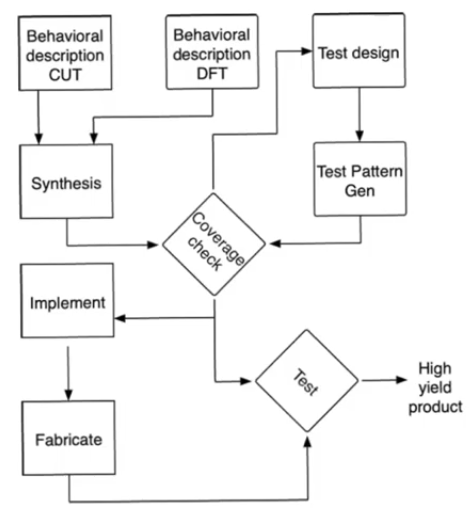Test design and fault coverage
- Source this playlist on Testing.
Design flow
- The design flow with DFT is modified a little than the normal design flow because of the presence of additional hardware for DFT
- You’ll have a behavioral description for the core chip and a behavioral description for the additional hardware of DFT
- These two are usually intertwined and it’s really difficult to separate them so they both may exist in the same design file
- After synthesis, you go through a test design phase
- In the test design phase you determine the test patterns to apply in the finished the inputs and the gold standard to compare with
- The gold model is usually obtained from one of the level in which the simulation is cycle accurate and bit accurate
- Then a coverage check that ensures that the test you are doing covers the majority of the faults that can occur
- Once you ensure that the tests are of good quality you go through implementation of the design that includes the DFT
- Then layout fabrication and then apply the tests to the chip if it works you can ship it out
- The ultimate aim is that the majority of the chips pass through the tests and also that the tests are practical (can be applied in a practical manner)

Testing flow
- To test hardware (finished chips) you have
- A platform to mount the chip and it has connectors to connect the pins of the chip automatically using a robotic arm
- Conditioning circuits allowing the chip to communicate with the test computer
- Test computer a specialized computer which uses a real time operating system (bare bones for efficiency)
- generates the test patterns
- apply them to the inputs of the CUT (circuit under test)
- The ouputs are then fed to the memory of the computer storing them as observations
- Carry out the comparisons with the gold standards
- produce test result saying the chip is functioning or not
- If the chip is good it goes to the “Good bin” and if it fails it goes to the “Bad bin”

- The main aim is to have chips that are mostly good
- The percentage of chips that work is called the yield
Test duration
- The time it takes to test the chip has two main components
- Time expended to do mechanical operation (moving the chip onto and out of the platform)
- assume in an efficient process it takes 5 seconds
- This is actually not an important figure
- because it’s an overhead, it’s calculated once per chip
- Time it takes to apply the test
- assume it takes 5 micro second per test includes
- generate the test pattern
- apply it to the CUT
- the CUT takes its time to produce an output
- All the conditioning circuits taking thier time to condition the signals
- the test computer comparing the observation to the gold standard and making a decision
- assume it takes 5 micro second per test includes
- Assume testing a NAND gate
- we have to cover its entire truth table,
- for
ninputs we have2^ntest cases
- for a simple 16-bit multiplier, we have 32 inputs so
2^32test cases, it’ll take roughly 11 hours - The delay for tests is dominated not by the mechanical overhead but the actual time of the test and comparison

-
Most circuits are not combinational circuit, they are pipelines containing combinational and sequential elements so calculating the test time becomes challenging
- Assume a circuit with
Minputs andNflip flops so it contains2^Nstates corresponding the theNregisters- We need to apply all the test vectors for all of the states
- the number of tests =
2^(N+M) - this can be huge and leads to severe problems
- assuming a simple data path circuit with 40 inputs and 40 states, this will require 383 billion years to be fully tested
- This means that we can’t do testing naively as described
Fault coverage
- Fault coverage (F) is the ratio between the number of faults that can be uncovered and the number of faults that could exist
- for example assuming (2^80) possible combinations of inputs and states
- how many faults that can occur inside this circuit (can be caculated using stuck-at fault)
- assuming 3000 different faults can occur
- if you apply a small number of tests you are gonna uncover some of them
- if you apply 2^10 test you gonna uncover for example 500 faults
- this doesn’t mean that 500 faults exist, it means the if one of the 500 faults exists one of the tests will uncover it
- so the fault coverage
F=500/3000
- how many faults that can occur inside this circuit (can be caculated using stuck-at fault)
- Fault coverage is a number that ranges between 0 and 1
- Applying
2^(N+M)tests (all possible tests),F = 1 - Applying 0 tests,
F = 0
- Applying
- Fault coverage increases rapidly for a small number of tests, and then it starts to saturate slowly
- The majority of faults can be uncovered by applying a small number of tests
- Perhaps we can tolerate the remaining small number of faults
- tolerate shipping chips that have these faults
- So we only apply a small number of tests that uncover the huge percentage of faults
- if the chip passes, it’s shipped out
- it has a possibilty that it contains a fault that wasn’t covered in the tests
- in that case the consumer has a faulty product and the vendor will replace it
- This can be quantified by calculating defect level
